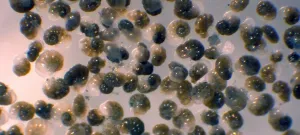(Press-News.org) DURHAM, N.C. - Decades after federal bans ended widespread use of lead in paint and gasoline, some urban soils still contain levels of the highly toxic metal that exceed federal safety guidelines for children, a Duke University study finds.
To conduct their study, the researchers analyzed and mapped soil lead concentrations along 25 miles of streets in Durham, N.C., a city of about 270,000 people. They found that while soil lead levels have generally decreased since the 1970s, they have decreased much less near residential foundations than along streets.
The researchers collected soil samples near foundations of houses built before 1978. Samples within a meter of the older homes averaged 649 milligrams (mg) of lead per kilogram (kg) of soil, more than three times the average level detected near streets, which was 150 mg/kg.
EPA guidelines say exposure to soil lead concentrations above 400 mg/kg is associated with potential long-term health risks to children, including possible damage to the brain and nervous system, slowed growth and development, learning and behavior problems and hearing and speech problems.
"Urban soil processes are driving lead concentrations down over time, but it's alarming that lead levels in some locations -- typically older, poorer neighborhoods -- still far exceed safe levels decades after leaded gasoline and lead paint were phased out," said lead author Anna Wade, a postdoctoral researcher at the U.S. Environmental Protection Agency and a 2020 Ph.D. graduate of Duke's Nicholas School of the Environment.
The Duke team shared its findings with Durham public health groups and plans to conduct similar mapping studies in five or six other cities nationwide.
Determining where contamination risks persist, and why contamination is decreasing at different rates in different locations, is essential for mitigating those risks, she said. However, many cities lack the resources to conduct the regular city-wide sampling needed to obtain that data. "Our study had to go all the way back to the 1970s to find comparable data for portions of the 35-square-kilometer area we sampled," Wade said.
Daniel D. Richter, professor of soils at Duke, said, "There's been a lot of interest in mitigating lead exposure in cities, but most is focused on reducing risks within the home. Our study reminds us about the outdoor environment where exposure risks also exist."
Wade, Richter and their team published their peer-reviewed, open-access study May 21 in Environmental Science & Technology.
Curbside soil lead levels have dropped over time as the result of human and natural causes, the study suggests. Those causes include accelerated erosion and stormwater runoff, which has carried away some contaminated surface soils, depositing them in nearby floodplains.
Digging for road construction and repair also contributed to the drop by mixing and burying some contaminated soil deeper underground.
Foundation soils are less affected by these processes. Also, soils near many older homes continue to receive chips and dust from old leaded paint. Soil lead levels are thus decreasing more slowly near older homes, and those soils continue to pose a higher risk.
Traffic density also factors into the risk equation.
In larger cities that see more traffic, such as New York or Chicago, soil lead levels along heavily travelled streets have historically been high. In larger cities, those levels may still be unacceptably high, Wade said. Implementing regular, widespread soil testing is the only way to know for certain.
"Large-scale sampling reveals patterns of soil lead distribution that you miss through spot checking," Richter said. "That can make the problem more predictable and remediable and encourage cities to act on this issue rather than just letting it be."
INFORMATION:
Wade and Richter's co-authors on the new study were Nancy Bao, Paul Heine, Mary Osteen and Kevin Tan, all of Duke, and Christopher Craft of Indiana University.
The study stemmed from a faculty-student research project that Wade and Richter led for Duke's Bass Connections program in 2018-2020.
CITATION: "Urban-Soil Pedogenesis Drives Contrasting Legacies of Lead from Paint and Gasoline in City Soil," Anna M. Wade, Daniel D. Richter, Christopher B. Craft, Nancy Y. Bao, Paul R. Heine, Mary C. Osteen and Kevin G. Tan; May 21, 2021, Environmental Science & Technology. DOI: https://doi.org/10.1021/acs.est.1c00546
Depression is the leading cause of disability worldwide. Neuroscientists from Synapsy - the Swiss National Centre of Competence in Research into Mental Illness - based at Lausanne University Hospital (CHUV) and Lausanne University (UNIL) have recently demonstrated that lactate, a molecule produced by the body during exercise, has an antidepressant effect in mice. Lactate is best known for the pivotal role it plays in the nutrition of neurons inside the brain. Yet it can also counter the inhibition of the survival and proliferation of new neurons, a loss ...
Normal cells usually have multiple solutions for fixing problems. For example, when DNA becomes damaged, healthy white blood cells can use several different strategies to make repairs. But cancer cells may "put all their eggs in one basket," getting rid of all backup plans and depending on just one pathway to mend their DNA. Cold Spring Harbor Laboratory (CSHL) Professor Christopher Vakoc focuses on probing cancers to figure out if they have any unique dependencies. His lab was surprised to discover that a single DNA repair method remained in acute myeloid leukemia (AML), an aggressive cancer that originates in bone marrow. They discovered that if they shut down that pathway in cells grown in the ...
New insights into the ability of DNA to overcome harmful genetic changes have been discovered by scientists at the Wellcome Sanger Institute, the University of Lausanne and their collaborators. The team found that 26 per cent of harmful mutations were suppressed by naturally occurring variants in at least one wild yeast strain. In each instance examined in detail, a single 'rescue mutation' was responsible for cancelling out another mutation that would have threatened the organism's survival.
The study, published today (27 May 2021) in Molecular Systems Biology, provides ...
Millions of surgical procedures performed each year would not be possible without the aid of general anesthesia, the miraculous medical ability to turn off consciousness in a reversible and controllable way.
Researchers are using this powerful tool to better understand how the brain reconstitutes consciousness and cognition after disruptions caused by sleep, medical procedures requiring anesthesia, and neurological dysfunctions such as coma.
In a new study published in the journal eLife, a team led by anesthesiologists George Mashour, M.D., Ph.D. of University of Michigan Medical School, Michigan Medicine, Max Kelz, M.D., Ph.D. of the University of Pennsylvania Medical School, and Michael Avidan, MBBCh ...
This striking image showcases the unusually contorted appearance of NGC 2276, an appearance caused by two different astrophysical interactions -- one with the superheated gas pervading galaxy clusters, and one with a nearby galactic neighbour.
The interaction of NGC 2276 with the intracluster medium -- the superheated gas lying between the galaxies in galaxy clusters -- has ignited a burst of star formation along one edge of the galaxy. This wave of star formation is visible as the bright, blue-tinged glow of newly formed massive stars towards the left side of this image, and gives the galaxy a strangely lopsided appearance. NGC 2276's recent burst of star formation is also related to the appearance of more exotic inhabitants -- black holes and neutron stars ...
What does quark-gluon plasma - the hot soup of elementary particles formed a few microseconds after the Big Bang - have in common with tap water? Scientists say it's the way it flows.
A new study, published today in the journal SciPost Physics, has highlighted the surprising similarities between quark-gluon plasma, the first matter thought to have filled the early Universe, and water that comes from our tap.
The ratio between the viscosity of a fluid, the measure of how runny it is, and its density, decides how it flows. Whilst both the viscosity ...
Woods Hole, Mass. (May 27, 2021) - With the expansion of oxygen-depleted waters in the oceans due to climate change, some species of foraminifera (forams, a type of protist or single-celled eukaryote) that thrive in those conditions could be big winners, biologically speaking.
A new paper that examines two foram species found that they demonstrated great metabolic versatility to flourish in hypoxic and anoxic sediments where there is little or no dissolved oxygen, inferring that the forams' contribution to the marine ecosystem will increase with the expansion of oxygen-depleted habitats.
In addition, the paper ...
Twenty scientists from 14 countries warn of a hidden "pandemic within the pandemic" in two current publications. On the one hand, physical activity levels have gone down significantly, on the other hand, psychological well-being has suffered. "Governments and those responsible for health systems should take our findings seriously," emphasizes the author team, headed by Dr Jan Wilke from the Institute for Sport Sciences at Goethe University Frankfurt.
About 15,000 people in participating countries answered standardised questionaires as part of an international survey. In April/May 2020, they reported physical activity levels (13,500 participants) as well as their mental and physical well-being (15,000 participants) ...
With global warming decreasing the size of New Zealand's alpine zone, a University of Otago study found out what this means for our altitude-loving kea.
The study, published in Molecular Ecology, analysed whole genome DNA data of the kea and, for the first time, its forest-adapted sister species, the kākā, to identify genomic differences which cause their habitat specialisations.
The researchers found the kea is not an alpine specialist, but rather one that adapted to using such an open habitat because it was least disturbed by human activity.
Co-author Associate Professor Michael Knapp, of the Department of Anatomy, says that is not likely to surprise people ...
Different from small molecules, polymer will fold into lamellar crystals during crystallization and further assemble into lamellar stacks.
Synchrotron Small-Angle X-Ray Scattering (SAXS) is an important tool to characterize such nanoscale structure and understand polymer crystallization. However, its scattering mechanism in semi-crystalline polymers is not completely elucidated yet.
Recently, a research group led by Prof. TIAN Xingyou from Institute of Solid State Physics, Hefei Institutes of Physical Science (HFIPS), proposed a complete set of new methods to characterize polymer lamellar crystals ...




